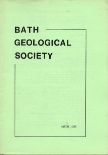The Cherry Gardens Railway Cutting Section

The Cherry Gardens Railway Cutting was used by the now abandoned LMS line from Mangotsfield to Bath and extends from Bitton Station (ST760.703) at present the headquarters of the Bristol Suburban Railway Society, for about a mile northwards. Figure 1 gives the location of the cutting the easiest access being from Bitton Station where a car can be parked. A cycle track and footpath runs northwards from the station alongside the railway line.
A detailed description of the section in the cutting was given by Charles Moore in a paper to the London Geological Society in 1867 (1), and in that paper he remarks that “I have never had the pleasure of seeing any other section to be compared with it”. The Mangotsfield to Bath line opened in mid 1869 so Charles Moore must have examined the section almost as soon as it was exposed, and in the hundred odd years since then the section had become grown over so that it was only possible to distinguish the broad outlines of the features described by Moore.
Recently under the direction of the National Conservancy Council part of the section has been cleaned, and whilst not now the magnificent section about which Charles Moore enthused, is never the less of considerable interest.
The section described by Moore extended from just north of the Bitton Station to the first railway bridge and Figure 2 is a sketch (adapted) from his paper.
The recent clearing has been carried out on the west wall of the cutting exposing part of the northern limb of the syncline and also the fault that brings the Pennant sandstone into contact with the younger formations. The change in lithology across the fault can now be clearly seen. The syncline to the south of the fault was considered by Moore to be of tectonic origin and with the “eye of faith” can be traced out in the uncleaned part of the section.
The Pennant sandstone both south and north of the railway bridge shows a variety of sedimentary structures and also contains characteristic plant fossils. In some places there is heavy iron staining and good examples of haematite and goethite, exhibiting a variety of forms, can be seen in the rock face and collected from loose blocks.
References
- MOORE C 1867 On Abnormal Conditions of Secondary Deposits when connected with the Somersetshire and South Wales Coal basin. Q.J.I. geol. Soc. Lond. 23, 449-568.
